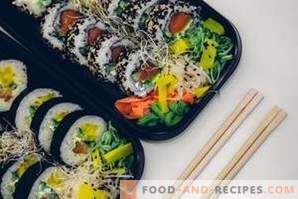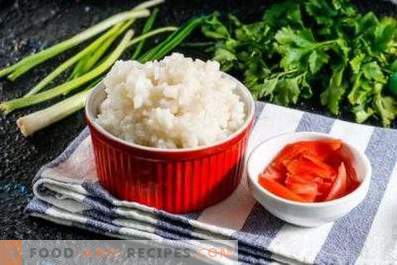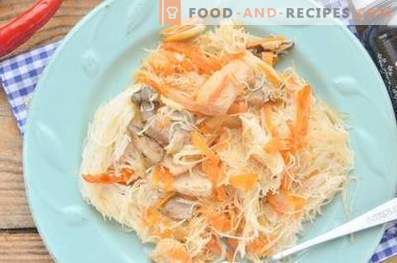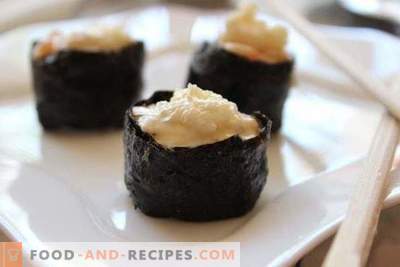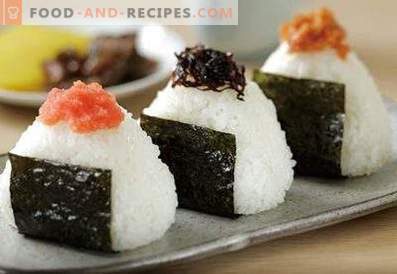
Onigiri is a traditional Japanese dish, which is often confused with sushi and rolls. Its main ingredient is rice, but it is not salted, it is not supplemented with vinegar or rice wine, sugar or soy sauce. The product must be bland. Balls or triangles are formed from rice, a substrate for them is made of algae and served to the table. To make such rice balls came up so that it was convenient to eat rice and take it on the road, using it as a snack. The name of the dish comes from the Japanese word, translated as “crimp”. This is due to the technology of cooking onigiri: rice pressed by his hands, forming balls. The filling is not a mandatory ingredient onigiri, but most often they are made with it. For the preparation of sushi or rolls you need to have a certain skill, but any hostess can make rice buns.
Cooking Features
The technology of making onigiri is extremely simple; even a novice cook can easily master it. You just need to know some points, otherwise the result will be very different from the expected, and not for the better.
- For the preparation of onigiri, sticky rice is required. Any varieties of this cereal suitable for sushi preparation will do. Ordinary round grain rice can also be used, after soaking it for half an hour in cool water.
- Water when cooking rice for onigiri is not salted; it requires an unleavened product. However, the filling should be sufficiently salty or savory to balance the taste of the finished dish.
- When cooking rice for onigiri, the grits are washed 7 times, dipped it in already boiling water. First, cook for 5 minutes over medium heat, then cook for 10 minutes over low heat, then allow to stand under the lid and reach the desired state for 15-20 minutes. By this time, the temperature of the product will be just that which allows you to work with it with your hands without risking burns.
- Traditional onigiri cooking technology involves the formation of a small ball (2-3 bites), in which a hole is made with a finger, a filling is put into it, then it is compressed with rice.
- Seafood products such as tuna, salmon, shrimp, and caviar are the most commonly used fillings for onigiri. One of the most favorite fillings in 40% of Japanese are salted plums. It is acceptable to use fresh and pickled vegetables, meat, chicken, seaweed.
- The filling can not be placed inside the rice ball, but immediately mixed with rice, and then formed from the resulting mass of the figures of the desired shape.
- You can form onigiri with your hands or with the help of a food film. It will be even easier to do this by using special molds.
- If you are cooking onigiri without a filling, you can add a little soy sauce and sesame oil to the rice.
- Before serving, onigiri is wrapped in strips of seaweed or made of them. Algae can be replaced with lettuce leaves or pancake omelet. The main task of the substrate is to prevent sticky rice from staining your fingers. Additionally, it helps to keep the shape given onigiri.
- Onigiri seaweed is wrapped before serving. If you do this in advance, nori will be sodden.
- Japanese women often decorate onigiri with pieces of seaweed, fruits, vegetables, sesame seeds, giving rice products similarities to funny faces.
Onigiri is served on white porcelain plates or wooden boards. To the dish you can offer green tea or sake.
Onigiri with salted plum
Composition:
- rice for sushi - 0, 2 kg;
- nori seaweed - 6-8 pcs .;
- salty plums - 3-4 pcs .;
- water - 0, 3 liters.
Preparation Method:
- Rinse rice to clean water.
- Boil water, put rice cereal in it.
- Cook for 5 minutes over medium heat.
- Reduce the intensity of the flame, continue cooking rice for 12 minutes.
- Turn off the fire. Leave the rice in a saucepan under the lid for 15 minutes.
- Divide the rice into 6-8 servings.
- Cut the plums in half.
- Cut a piece of cling film, put it on the board.
- Spread one portion of rice onto film, put half of the plum in the center.
- Lift the edges of the cling film; use it to form a triangle of rice so that the plum is in the center.
- Remove food wrap.
- Wrap the triangle with a strip of nori so that it runs along its edges.
- In the same way, make onigiri from the remaining portions of rice and plums.
Instead of halves of salted plums, you can use pieces of pickled cucumbers or other vegetables, dried tomatoes, olives or olives.
Onigiri with salmon and cream cheese
Composition:
- rice for sushi - 0, 4 kg;
- water - 0, 5 l;
- salted salmon (fillet) - 0, 2 kg;
- cream cheese - 150 g;
- sesame oil - to taste;
- Nori - 12 pcs.
Preparation Method:
- Rinse, lower the rice into the boiling water. After boiling on an intense fire for 5 minutes, reduce the intensity of the flame and continue cooking for 10 minutes.
- Leave to swell and cool under cover for 20 minutes.
- Add oil, mix.
- Finely chop the lightly salted salmon fillet, add cream cheese, mix well.
- Place a large spoonful of rice on a piece of cling film and slightly flatten it.
- Place a small spoonful of stuffing in the center.
- By lifting the ends of the film, form a rice ball. The filling should be in the center.
- Remove the film. Wrap a rice ball with a strip of seaweed. Put on a plate.
- In the same way, make balls from the remaining rice.
When serving rice balls can be sprinkled with sesame seeds. Onigiri stuffed with salmon fish are very popular in Japan. Europeans also like their taste.
Onigiri with tuna
Composition:
- coarse-grained rice - 0, 4 kg;
- water - 0, 6 l;
- canned tuna - 0, 25 kg;
- mayonnaise - 50 ml;
- lettuce leaves - as required.
Preparation Method:
- Rinse the rice to clear water, fill with clean water, leave for half an hour.
- Put on a quick fire, bring to a boil.
- Turn down the flame, cook for 15 minutes.
- Remove rice from heat. Cool to a comfortable temperature.
- Wet your hands in salt water to form rice balls about 3, 5 cm in diameter.
- Put the tuna in a bowl, mash with a fork, add mayonnaise, mix.
- In each ball make a recess with your finger, put a tuna filling in it. Crimp so that the filling is inside.
- Wash, dry lettuce leaves. Wrap the rice balls in them, put on a dish.
If you are not ready to eat unleavened rice, even with a delicious filling, boil it in salted water.
Onigiri in an Omelet
Composition:
- chicken egg - 3 pcs .;
- corn starch or flour - 20 g;
- mayonnaise - 20 ml;
- rice - 0, 2 kg;
- water - 0, 3 l;
- pollock or cod roe (breakdown, salty) - 100 g;
- vegetable oil - as needed.
Preparation Method:
- Combine eggs, mayonnaise and starch. Whisk with a whisk to get a homogeneous mass. You can lightly salt and pepper, add dried greens.
- Preheat pan, brush with oil. Fry the omelet in the form of thin pancakes, pouring the dough into the pan in small portions.
- When the omelet pancakes are cool, cut them into strips.
- Boil rice in unsalted water, mix it with caviar.
- Form rice balls or triangles. This can be done with food film or hands. To prevent rice from sticking to your palms, soak them in salt water.
- Wrap the onigiri with an omelet, sprinkle with fresh herbs, chop it up finely, and serve it to the table.
Omelet pancakes can be used instead of seaweed when cooking onigiri with any filling.
The traditional Japanese dish of onigiri has no specific taste, it will appeal not only to fans of Asian cuisine. It is easy to prepare this dish, even an inexperienced hostess will cope with the task. You just need to know how to cook rice. Onigiri stuffing can be prepared according to your taste from meat, seafood, salted vegetables.
